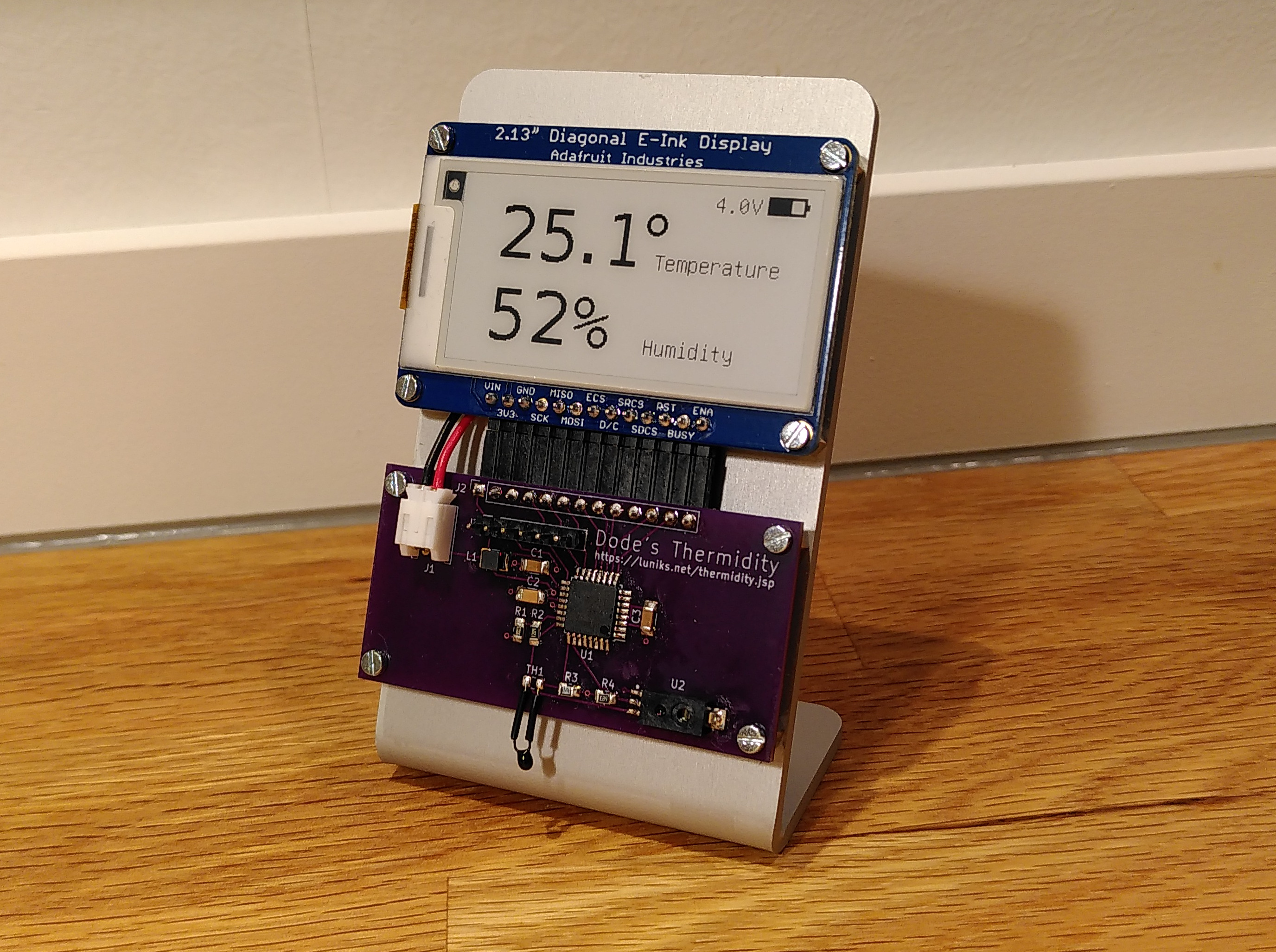Thermidity
AVR MCU based battery powered thermometer and hygrometer with e-ink display.
Focus is on stable, accurate measurements and low power consumption.
And of course on a nice, simple display.
The project is based on avrink and uses the following components:
- MCU AVR ATmega328P
- Thermistor NTC 100kΩ 0.1°C
- Humidity Sensor HIH-5030
- E-Ink display Adafruit Monochrome 2.13" 250x122
- Driver SSD1680
- SRAM 23K640
- SD Card Reader (not used)

Accuracy
AD conversion is done with 16x oversampling, yielding 12-bit virtual resolution with the 10-bit ADC, provided the signal contains some noise.
Each time measurements were taken, a moving average is updated which is used to calculate and display temperature, humidity and battery voltage.
A precision thermistor and precision low-voltage humidity sensor are used:
| Component | Accuracy |
|---|---|
| Thermistor | ¹±0.1°C |
| HIH-5030 | ±3%RH |
¹Series resistor 0.1% tolerance
Power Consumption
Estimated average power consumption is about 30µA when measuring every 32 seconds and updating the display once in about 5 minutes, hopefully giving an operating time of about 3 years with 3 AAA batteries (1100 mAh, 6% self-discharge).
The consumption of each component at 3.8V and 22°C is about:
| Component | Data Sheet | Measured |
|---|---|---|
| ATmega328P | ¹4.2µA | 4.5µA |
| Thermistor | N/A | 24µA |
| HIH-5030 | ²200µA | 211µA |
| V-Divider | N/A | 2µA |
| Display | ³N/A | 14µA |
¹VCC = 3V, power-down sleep mode
²VCC = 3.3V
³Display in deep sleep mode + SRAM + SD Card Reader + Bus Transceiver
Between taking measurements, the MCU is set to power-down sleep mode with the watchdog used as wake-up source. Additionally, the thermistor and humidity sensor are powered off and between display updates, the display is set to deep sleep mode. Power consumption (measured) then is about 19µA at 3.8V for MCU and display.
When measuring temperature, humidity and battery voltage in ADC noise reduction mode, consumption seems to be somewhere around 2mA for 6ms, plus a brief additional MCU awake period for updating the moving average with measured values. Before measuring, the sensors are powered on and given 100ms to settle, consuming about 240µA.
When updating the display, consumption is at around 6mA for about 3 seconds. Before that, the MCU has to calculate and format the average measurements and buffer the frame in SRAM.
The display is updated in fast update mode, taking 1.5s instead of 3s for full update mode, saving a considerable amount of power. To avoid ghosting effects, every 10th update is a full update.
When no measurement has changed, the display is not updated at all to extend its lifetime and to save more power.
Below the cutoff voltage of 3.0V, the watchdog is disabled to stop measuring and updating the display, to at least delay total discharge of the batteries. Consumption of the MCU then is at about 1µA and 19µA of the display.
The clock of unused modules TWI, all three timers and USART is switched off to reduce power consumption.
Disabling the ADC between measurements and the SPI between display updates both contributes to a significant reduction of power consumption. With an enabled SPI, consumption of the display including its peripheral is extremely unstable and varies between some tens of microamps and several milliamps. When driving the enable pin of the display low, consumption is stable at about 60µA. When not driving the enable pin low and disabling SPI (driving SCK pin low) consumption is at about 14µA.
Project on GitHub
AVR firmware, KiCad PCB, FreeCAD frame
Comments? dode@luniks.net